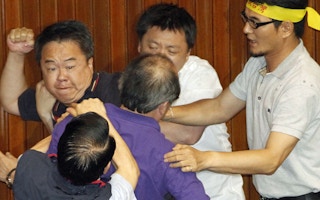East Asia is facing another nuclear dilemma, and this time it isn’t North Korea. Japan, Taiwan and South Korea are all debating their domestic nuclear-power programs, which are endangered by natural disaster, corruption, nervous politics and regulatory capture.
Start with Japan, site of the 2011 earthquake and tsunami that caused a meltdown at the Fukushima Daiichi nuclear plant. The latest news is that the crippled plant is leaking 300 tons of radioactive water into the Pacific Ocean every day—and has been doing so for two-and-a-half years. In response, Tokyo will step up its decontamination role.
The bad Fukushima news complicates Prime Minister Shinzo Abe’s plans to restart nuclear reactors idled since 2011. At the time 70 per cent of Japanese supported taking the reactors offline, especially as evidence emerged that the disaster “was the result of collusion between the government, the regulators and [Fukushima owner] Tepco,” as a parliamentary panel put it in a 641-page report last month.
Meanwhile, in Taiwan this week a government watchdog revealed that for three years a nuclear plant has leaked small amounts of toxic water. Officials claim the leak is contained inside the plant, but this hurts the government’s push to open the island’s fourth nuclear reactor, which is more than 90 per cent complete but tied up in political controversy. The ruling party wants a popular referendum on opening the plant, but an Aug. 2 debate on the plan ended in a legislative brawl—literally—with punches and water thrown.
South Korea is also sweating through August with six of its 23 nuclear plants offline, leading the energy minister to warn that Seoul may have to initiate rolling blackouts. To conserve energy, government agencies have shut off their own air conditioning, put subway trains on a reduced schedule, threatened to fine shopping malls that bring temperatures below 26 degrees Celsius (78.8 Fahrenheit), and encouraged businesses and households to stagger daytime consumption.
South Korea’s problems relate to a scandal last November when Seoul shut down two reactors found to contain thousands of parts installed with forged safety certificates. Authorities took two more reactors offline in May after finding more evidence of forgeries and bribes to officials who looked the other way at the state-financed Korea Hydro & Nuclear Power Company. Of the six reactors now offline, three are undergoing regular maintenance and three are tied to the scandal as they await certified replacement parts.
South Korea’s goal has been to build 16 new reactors by 2030, increasing nuclear’s share of national electricity generation to 59 per cent from 35 per cent. Officials also tout nuclear’s potential as an export industry, and in 2009 Seoul won a $20 billion contract to build four nuclear reactors in the United Arab Emirates. South Korean confidence in domestic nuclear energy was then 71 per cent, according to a January 2010 government survey. By this January, it was below 35 per cent.
***
The region-wide problem is that if nuclear power is cashiered, something will have to take its place. Wind, solar and geothermal couldn’t begin to make up the difference if Japan dropped its 30 per cent reliance on nuclear. Same goes for Taiwan’s 18 per cent nuclear share and South Korea’s 35 per cent. The only alternative is increased oil and gas imports—meaning higher energy prices and greater vulnerability to supply shocks. To make up for their idling nuclear plants, the Japanese last year spent an additional 0.7 per cent of gross domestic product on imported fuel.
As for meltdowns, the United Nations Scientific Committee on the Effects of Atomic Radiation concluded in January that, “Radiation exposure following the nuclear accident at Fukushima-Daiichi did not cause any immediate health effects. It is unlikely to be able to attribute any health effects in the future among the general public and the vast majority of workers.” The World Health Organization reached similar conclusions in February.
The case for nuclear power in Asia remains strong. But that requires politicians, regulators and an industry that can show they can operate nuclear plants safely and transparently. Ending the revolving door between regulatory agencies and industry and forbidding regulators from holding stock in companies they are supposed to monitor would be a good place to start. Only then can the nuclear industry regain public trust.

















